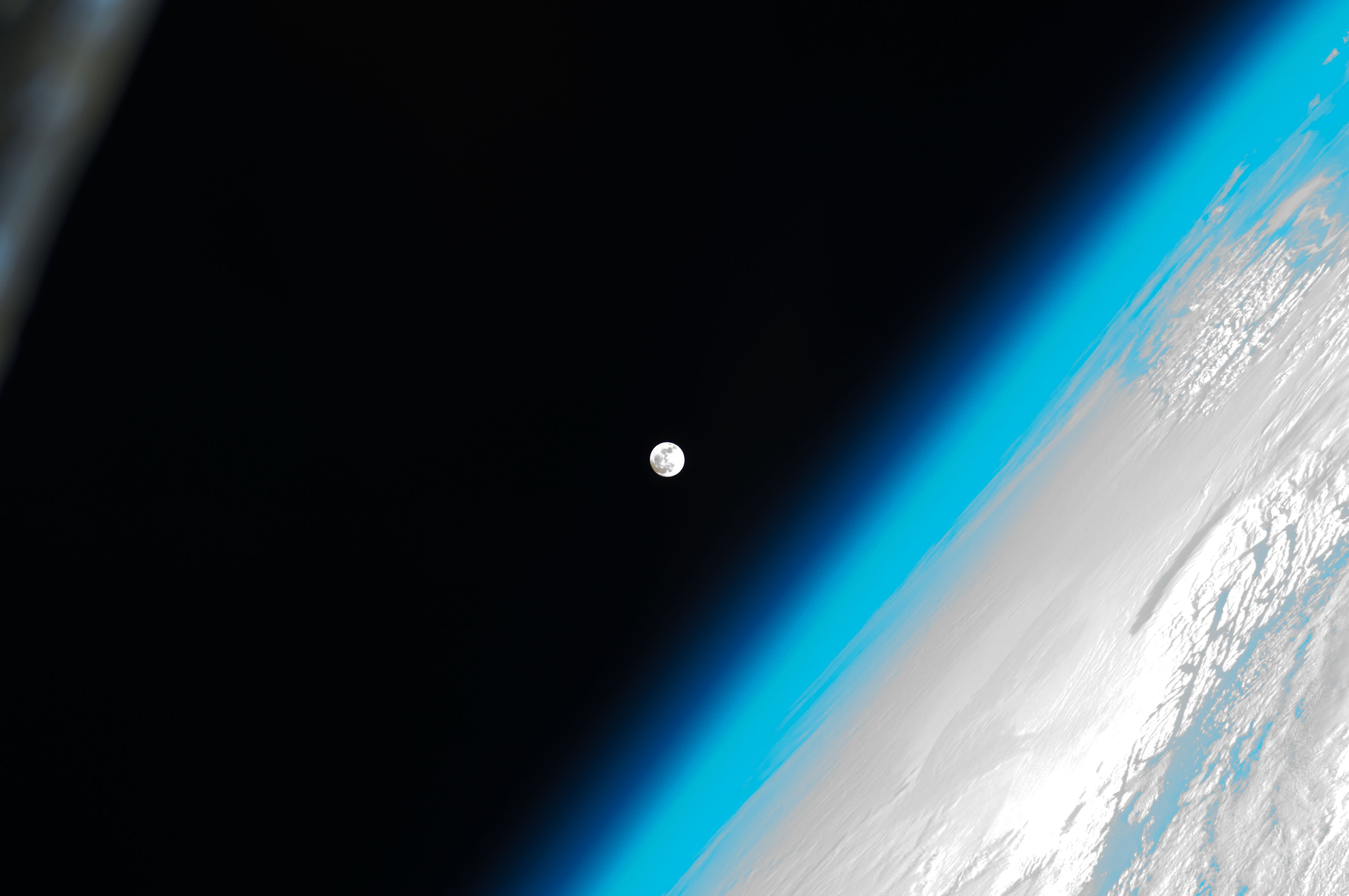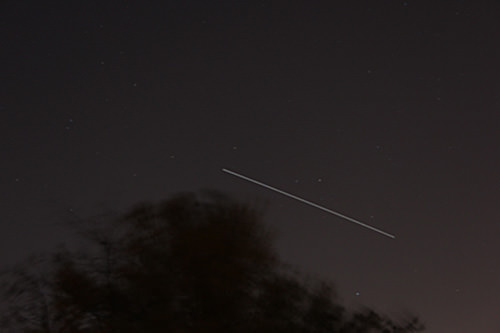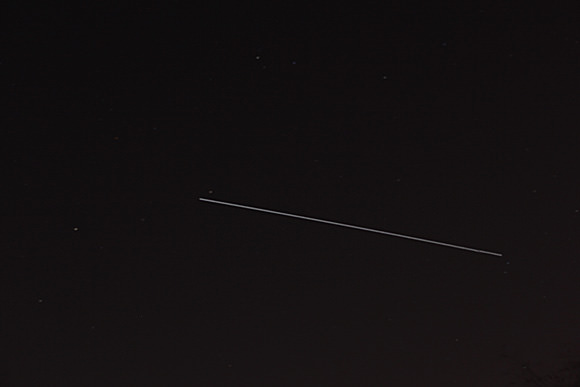[/caption]
A lovely view for the start of your week: The Moon and Earth’s atmosphere as seen from the International Space Station, taken by a member of the current Expedition 30 crew. See more images from the crew here.

[/caption]
A lovely view for the start of your week: The Moon and Earth’s atmosphere as seen from the International Space Station, taken by a member of the current Expedition 30 crew. See more images from the crew here.
[/caption]
The Center for the Advancement of Science in Space (CASIS) has opened part of the ISS exterior to research experiments via NanoRacks, a company providing plug-and-play platforms aboard the Station to third-party research organizations. For the first time, commercial experiments will have a dedicated external space aboard the ISS, putting them on “the front porch of the Universe.”
Since 2009 NanoRacks has been providing research institutions with shoebox-sized consoles that can house customized experiments for installation inside the U.S. National Laboratory on board the ISS.
On April 12 CASIS announced a $1.5 million deal with NanoRacks that will allow an external “NanoLabs” platform to be installed on the Japanese Kibo module. The structure will provide research spaces up to 8″ square that will be exposed to the environment of space. (Watch a video of the NanoLabs concept below.)
Through the CASIS investment, as many as four companies will be able to fly experiments for little or no cost.
A formal solicitation to research companies and private enterprises for payload proposals will be issued by CASIS in June. The NanoLabs platform is expected to be ready for flight by 2013 — a full year ahead of schedule.
“CASIS’ investment ensures that U.S. researchers will have access to the ISS External Platform far sooner than otherwise expected,” stated Jeffrey Manber, Managing Director of NanoRacks . “This program will enable faster innovation and spiral development for payloads — an opportunity that has not previously been made available to the commercial marketplace.”
Read the full press release here.
NanoRacks LLC was formed in 2009 to provide quality hardware and services for the U.S. National Laboratory onboard the International Space Station. The company operates the first commercial laboratory in low-earth orbit. The Center for the Advancement of Science in Space (CASIS) was selected by NASA in July 2011 to maximize use of the International Space Station U.S. National Laboratory through 2020.
Image: S134-E-011413 — A backlit ISS photographed by the STS-134 crew of Endeavour on May 29, 2011, after undocking from the Station. (NASA)
[/caption]
Astronaut Don Pettit is not only a scientist and on-orbit fix-it guy extraordinaire, but he is also a poet. Who knew? Since April is National Poetry Month, Pettit has written a couple of poems while on his tour of duty on the International Space Station. “By venturing into unknown territory, discoveries will be made that tickle our imagination and enrich our minds,” he says. “On the frontier, you can once again see the world through the eyes of a child.”
Read two of his recent poems, below:
I Wonder Why
I wonder why the sky is up, and why the stars abound?
And why the Sun comes up each morn, and why the Earth goes ’round?
I wonder what the Sun on Mars, would bring at dusk and dawn?
I wonder what two moons would say, from Earth lit sky when Sun is gone
I wonder if Mars mountain crags would be a sight to hold?
I wonder if I’d dare to climb, how could I be so bold!
I wonder when Man’s mind will grow, and cease to be so small
I wonder when we’ll venture forth, I hope before we fall
I wonder if we’ll never dare, to reach up through the sky
Forever doomed to live on Earth, and this, I wonder why?
Space is My Mistress
Space is my Mistress,
and she beckons my return.
Since our departure I think of you
and yearn to fly across the heavens arm in arm.
I marvel at your figure,
defined by the edges of continents.
You gaze at me with turquoise eyes,
perhaps mistaken for ocean atolls.
You tease me to fall into your bosom,
sculptured by tectonic rifts,
only to move away as if playing some tantalizing game.
Time and time we turn together,
through day, and night, and day,
repeating encounters every 90 minutes with a freshness,
as if we have never seen our faces before.
We stroll outside together,
enveloped by naked cosmos,
filled with desire to be one.
So close,
you sense my every breath,
which masks your stare through visor haze.
We dance on the swirls of cloud tops,
while skirting the islands of blue.
You know my heart beats fast for you.
Oh, Space is my mistress,
and when our orbits coincide,
we will once again make streaks of aurora across the sky.
See more of Pettit’s musings at his NASA blog.
[/caption]
Usually astronauts have to go much farther away than low Earth orbit to see the entire world in one view, but The World Islands resorts in Dubai provides a unique — if not manufactured — view of Earth’s continents from space. The World Islands are a collection of man-made islands shaped into the continents of the world, and ultimately will consist of 300 small private artificial islands divided into four categories – private homes, estate homes, dream resorts, and community islands.
To the east is another man-made archipelago named The Palm, for obvious reasons, and another island chain is due to be built between these reclaimed lands which will be called The Universe.
ESA astronaut André Kuipers took this image on April 10, 2012 during his long duration mission on the International Space Station. See more of his images at the ESA FLickr page.
[/caption]
Tracing a bright star upon the Earth, the lights of Russia’s capital city blaze beyond the solar panels of the International Space Station in this photo, captured by the Expedition 30 crew on the night of March 28, 2012.
As an electric-blue dawn flares around Earth’s northeastern limb, the green and purple fire of the Aurora Borealis shimmers and stretches away to the northwest above a pale yellow line of airglow.
Traveling at 17,500 miles an hour (28,163 km/hr), the ISS was approximately 240 miles (386 km) above the Russian city of Volgograd (formerly Stalingrad) when this photo was taken.
Image: NASA

Calling all Skywatching and Space Fans ! This is a great week for observing the International Space Station (ISS), swiftly crossing the evening nighttime sky.
All this week from Monday thru Saturday, folks all across vast portions of the United States and Canada will be treated to fabulous viewings of the International Space Station. And at very convenient viewing times in the early evening, after dinner and in prime time.
From Maine to Vancouver, from Ohio to Texas, from Florida to New Mexico – many of you will be in for a rather pleasurable ISS treat.
Of course the exact viewing times, days, elevations, durations and directions varies greatly depending on your exact location – and clear skies. And the viewing parameters change daily.
Check out this NASA website for Human Spaceflight Sighting Opportunities. It’s simple. Just plug in your country, state and select a local town. Also check out – Heavens Above.
This evening, Monday April 9, I shot a few 20 to 30 second exposures as the ISS was speeding past at about a 30 degree elevation. But the best viewings at far higher elevations are yet to come the remainder of this week.

The International Space Station is the brightest manmade object in the night sky and even brighter than Venus depending on orbital mechanics. Only our Sun is brighter. Since Venus is an evening observing target this week, maybe you’ll even be lucky to see the ISS seem to pass close by that hellishly hot planet.
Have you ever looked at the ISS hurtling overhead ?
Take some shots and send them to Ken to post here at Universe Today.
And remember, 6 Humans from the US, Russia and the Netherlands are currently residing aboard the ISS, conducting science research and sending back gorgeous shots of all of us back here on Earth.
Some lucky sixth-, seventh- and eigth-graders at the O. Henry Middle School in Austin, Texas got the chance to chat with Expedition 30 astronauts Dan Burbank, Don Pettit and Andre Kuipers aboard the International Space Station today, getting answers to their questions about life in orbit. The video was shared by NASA TV shortly after. Enjoy!
Credit: NASA
The heaviest cargo ship ever has arrived and docked to the International Space Station, laden with 7 tons of supplies for the 6-member ISS crew. The 20-ton European ATV-3 cargo ship, named “Edoardo Amaldi” after the Italian physicist and spaceflight pioneer, made a “smooth and gentle” docking on March 28, 2012, the European Space Agency said. The supplies delivered included food, drinking water, clothing, oxygen, spare parts and fuel.
The ATV launched from Kourou, French Guiana last Friday. It will use its engines to boost the space station during its 5-month stay on orbit. It is scheduled to undock on August 27 and perform an “orbital cremation” of trash from the space station.
“As you can imagine, all works comes to a stop on the Space Station when the toilet breaks,” said astronaut Don Pettit, known as Mr. Fixit among the astronaut corps. In this latest edition of “Inside the International Space Station,” Expedition 30 astronauts Dan Burbank and Don Pettit discuss their glamorous life in space of having to fix the toilet, upgrade their computers, and take out the garbage. This sounds just like living on Earth, but there are a few orbital twists for doing those things in space. And of course Pettit nails it with his vivid descriptions.
It’s a dirty job but somebody’s gotta do it.
Time for your daily dose of awesomeness from the ISS! Here’s a time-lapse video of the Aurora Australis photographed by Expedition 30 crew members on March 4, as the Station passed 240 miles (386 km) over the chilly waves of the southern Indian Ocean. Absolutely gorgeous!
Continue reading “Sky Candy: Southern Lights Over The Indian Ocean”